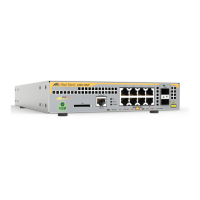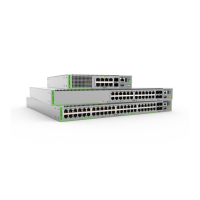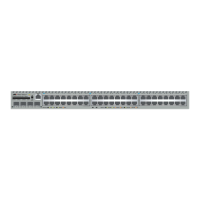852 Command Reference for x230 Series Edge Switches C613-50055-01 REV A
AlliedWare Plus™ Operating System - Version 5.4.5-0.x
AUTHENTICATION COMMANDS
AUTH
DYNAMIC-VLAN-CREATION
auth dynamic-vlan-creation
Overview This command enables and disables the Dynamic VLAN assignment feature.
The Dynamic VLAN assignment feature allows a supplicant (client device) to be
placed into a specific VLAN based on information returned from the RADIUS server
during authentication, on a given interface.
Use the no variant of this command to disable the Dynamic VLAN assignment
feature.
Syntax
auth dynamic-vlan-creation [rule {deny|permit}] [type
{multi|single}]
no auth dynamic-vlan-creation
Default By default, the Dynamic VLAN assignment feature is disabled.
Mode Interface Configuration for a static channel, a dynamic (LACP) channel group, or a
switch port.
Usage If the Dynamic VLAN assignment feature is enabled (disabled by default), VLAN
assignment is dynamic. If the Dynamic VLAN assignment feature is disabled then
RADIUS attributes are ignored and configured VLANs are assigned to ports.
Dynamic VLANs may be associated with authenticated MAC addresses if the type
parameter is applied with the rule parameter.
The rule parameter deals with the case where there are multiple supplicants
attached to a port, and the type parameter has been set to single-vlan. The
parameter specifies how the switch should act if different VLAN IDs end up being
assigned to different supplicants. The keyword value deny means that once a
given VID has been assigned to the first supplicant, then if any subsequent
supplicant is assigned a different VID, that supplicant is rejected. The keyword
value permit means that once a given VID has been assigned to the first
supplicant, then if any subsequent supplicant is assigned a different VID, that
supplicant is accepted, but it is actually assigned the same VID as the first
supplicant.
Parameter Description
rule VLAN assignment rule.
deny Deny a differently assigned VLAN ID. This is the default rule.
permit Permit a differently assigned VLAN ID.
type Specifies whether multiple different VLANs can be assigned to
supplicants (client devices) attached to the port, or whether only a
single VLAN can be assigned to supplicants on the port.
multi Multiple Dynamic VLAN.
single Single Dynamic VLAN.

